This four image mosaic comprises images taken with Rosetta’s NAVCAM on 1 December from a distance of 30.1 km from the centre of Comet 67P/Churyumov-Gerasimenko. The image resolution in the mosaic is 2.4 m/pixel and after cropping, it measures 3.8 x 3.5 km. The individual 1024 x 1024 frames, which are provided at the end of this post, measure 2.6 km across.
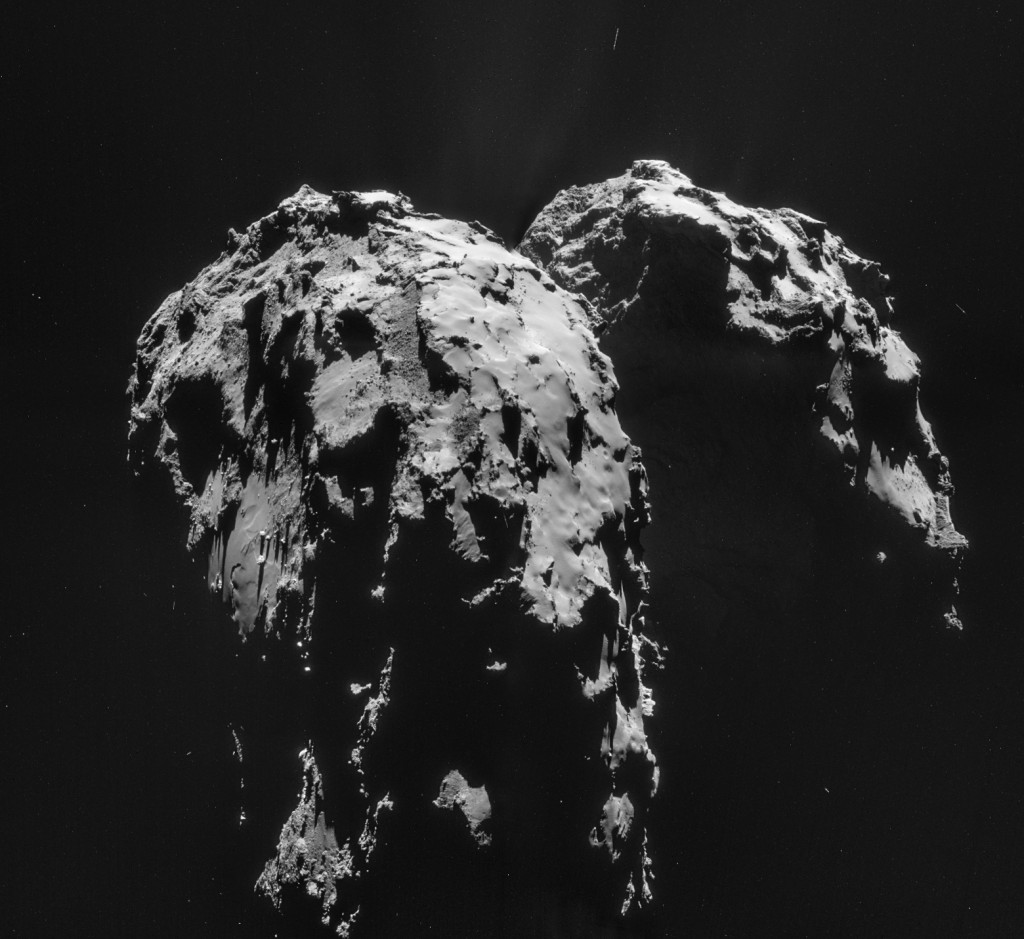
Four image NAVCAM mosaic comprising images taken on 1 December 2014. Credits: ESA/Rosetta/NAVCAM – CC BY-SA IGO 3.0
In this orientation, the smaller of the two comet lobes is towards the upper right of the scene, with the larger lobe in the lower left.
As ever, due to rotation and translation of the comet during the image taking sequence, making a mosaic involves some compromises, as features change slightly from one image to the next. For example, in this mosaic, there is an obvious flaw at the ‘join’ between the images connecting the large lobe (in the foreground) and the smaller lobe (in the background).
There was enough of a shift between the top-left and top-right images to make the match here difficult, resulting in some minor feature and intensity mismatches. The small distortion correction made in the mosaicking process also changed the scale of the image slightly. Thus, as usual, before interpreting the mosaic, do check the original frames, and/or the montage below.
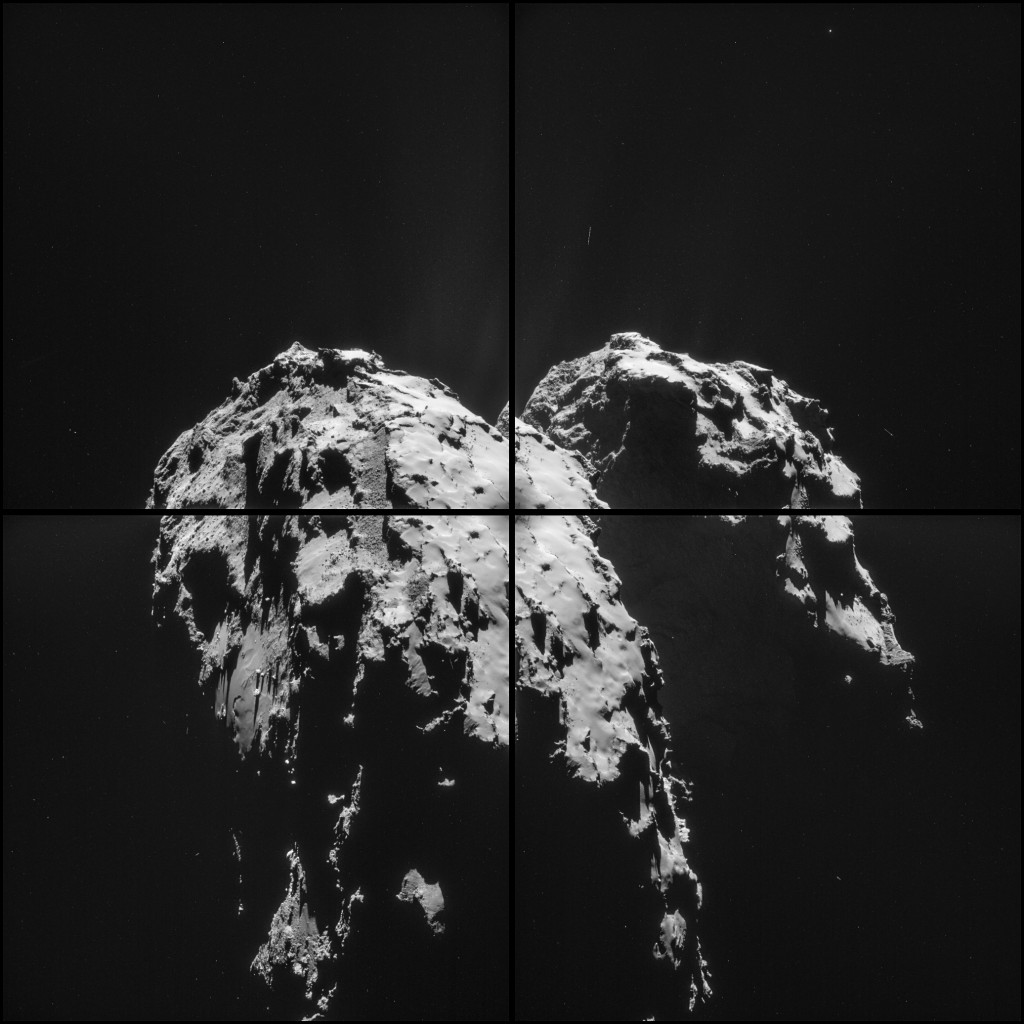
Four image NAVCAM montage comprising images taken on 1 December 2014. Credits: ESA/Rosetta/NAVCAM – CC BY-SA IGO 3.0
The view around the horizon in the upper frames is particularly striking, with cliffs, ridges and spires contributing to the dramatic scenery.
The familiar site that includes the Cheops boulder can be seen in the centre of the lower left frame in this montage, with long shadows cast onto the surrounding plain.
A similar viewing angle was seen during the close 10 km orbit – click here to revisit this entry.
Rosetta is now currently en route to a 20 km circular orbit around the comet, where it will operate for around ten days before returning to the 30 km orbit.
The four individual images making up this montage are provided below.

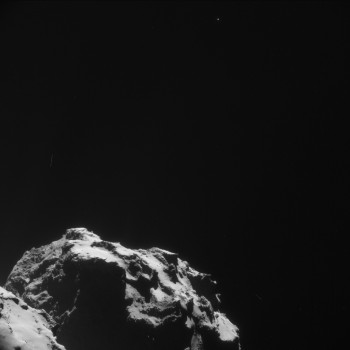
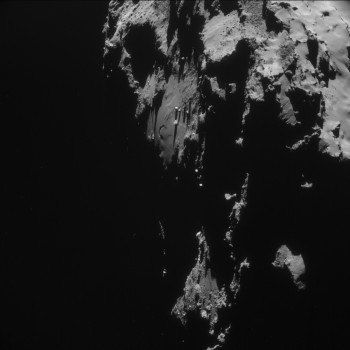
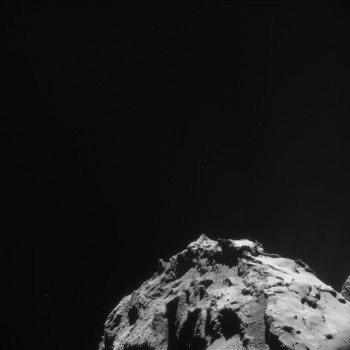
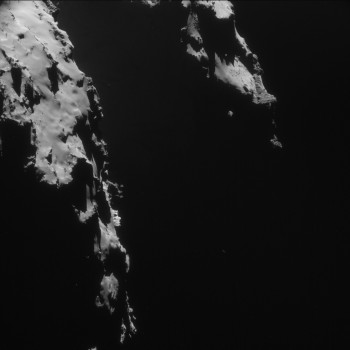








Discussion: 14 comments
Translucent ices ‘glowing’ in the dusk. Those are not ‘dirty’ ones 🙂
Pixel 592,1583 of dec1 mosaic
Do we have experiences of sinter materials under a heavy electrical field?
maybe this is of interest to you
https://www.google.de/url?sa=t&source=web&rct=j&ei=qyKHVJ_xH4urOo7lgZgD&url=https://www.igsoc.org:8080/journal/6/46/igs_journal_vol06_issue046_pg505-514.pdf&ved=0CDAQFjAC&usg=AFQjCNEuaDkD8pHOR9mLDz4IrccJugb_Qg&sig2=n6nYv3MMR9VX_Vq5Q49lew
Pixel 693,1612 of dec01 mosaic. Could that be a frozen ‘water-jet’?
Looking back to the incredible Philae landing…. I noted that the pictures showing the beginning of the descent from Rosetta showed the axial spin of the craft, including the landing legs. Were the legs despun just prior to touchdown? If not, it is likely that one hit first and caused the first bounce. Indeed, all the spin energy would have been considerable, compared to the micro gravity of the comet. The body of the craft would need to keep spinning until the feet had anchored.
Many thanks and congratulations to the team at ESA for all this wonderful stuff.
I have been tinkering with another of the CIVA images from the panorama taken of Philae’s final touchdown point. To save space here, I have added my comments to the two images. The first is the tweaked image and the second is an annotated one to highlight what I think are the pertinent features. Just like the backwards facing image this has a few surprises in it too.
https://www.flickr.com/photos/124013840@N06/15923257896/in/photostream/
https://www.flickr.com/photos/124013840@N06/15947093071/in/photostream/
Very clear pictures and thank you for publishing with expaination.
No dirty snowball is it ?
Comets look same as asteroids except they are active.
Turns out The Universe is Electric.
Feynman was right “gravity is not enough…” 1983.
At the lower left frame near heops we can se something like lava tube on mars…
You do such a fantastic job – you have my deepest admiration – thank you so much for this experience …
Extreme warping of minds here. Are you seeing the same as us? No man in the middle?
Bye Gotcha
Agree with you there Ashley
Hi Robin,
Above all, it contains the same major “surprise” as the previous CIVA image you highlighted, namely the all-pervasive fine stratification of the rock (this time running down in an 11 o’clock – 5 o’clock direction).
Thanks for bringing this too to our attention, Robin.
Again, I find it slightly surprising that these two (admittedly less spectacular) CIVA images have not been more widely publicized and their most salient features commented on by all concerned. Even if less spectacular than the famous up-front image which Mattias Malmer has so brilliantly reprocessed (dhttps://mattias.malmer.nu/2014/11/civa-depth-cues/comet_depth_cues/), they still contain essential information about the totally surprising nature of Philae’s final resting place.
The layers seen in Robin Sherman’s close up photos reminds me of layers in snow drifts.